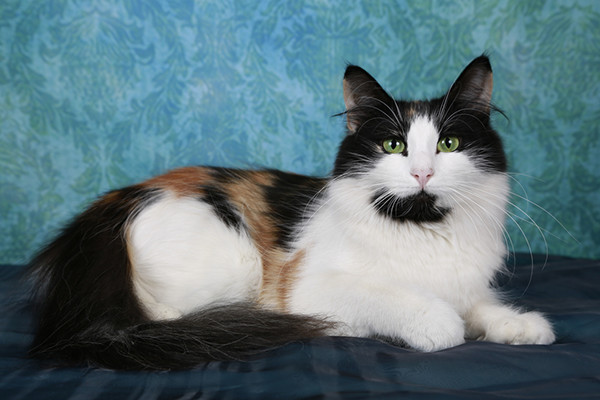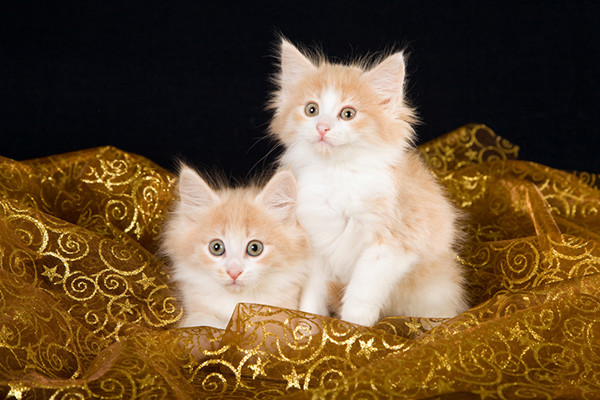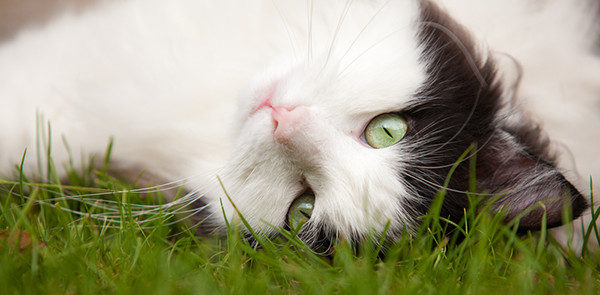At first glance, it’s easy to confuse a Norwegian Forest Cat with a Maine Coon or a Siberian — after all, the three breeds almost certainly share some distant common ancestry — but the Wegie, as it is known by its fans, has its own distinctive look, history, and temperament.

Origins
The Skogkatt, as it is known in its native land, has served for more than 1,000 years as a hardy companion on farms, on ships, and in villages. The breed was discovered by cat fanciers in 1938, and the Norwegian Forest Cat Club formed over a desire to preserve the breed. The efforts were derailed by World War II, and the breed almost died out. However, the Wegie made a comeback thanks to the work of the Norwegian Forest Cat Club and the late King Olaf’s proclamation of it as the official cat of Norway.
The first Norwegian Forest Cats were imported into the U.S. in 1979. The International Cat Association recognized the breed in 1984, and the Cat Fanciers Association in 1993.

Appearance
The Wegie’s weather-resistant semi-longhaired coat comes with a thick ruff around the chest, fluffy “britches,” and a big bushy tail as long as its body. That beautiful coat comes in a dazzling array of colors and patterns, although chocolate, lilac, fawn and cinnamon are disallowed, as are colored “points.” The Norwegian Forest Cat’s face is shaped like an equilateral triangle, with a pointy chin widening toward medium to large, heavily tufted ears. The Wegie’s almond-shaped eyes are usually copper, green, or gold, although white cats may have blue eyes or odd (one blue and one of another color) eyes.
Fully grown males weigh between 12 and 16 pounds, while fully grown females between nine and 12 pounds.

Health and longevity
Norwegian Forest Cats typically live between 14 and 16 years. Although they are a native breed, the decline of the breed’s population during World War II has taken a toll on its general health. Wegies are more prone to hypertrophic cardiomyopathy than many breeds. Polycystic kidney disease and glycogen storage disease type IV are found at higher-than-average numbers in the Norwegian Forest Cat as well.
The Norwegian Forest Cat is one of very few cat breeds known to be prone to a painful and potentially disabling condition known as hip dysplasia, a deformity in the socket that holds the hip joint in place, which can be very mild or can lead to severe lameness. If you are planning to breed your Wegie, be sure to have his or her hips X-rayed to determine whether the condition is present.

What it’s like to live with a Norwegian Forest Cat
The Wegie is a moderately active cat who loves to climb. Make sure your Norwegian Forest Cat has plenty of high perches and cat trees that are strong enough to support his weight. He’s also very intelligent and will enjoy the challenges of clicker training and puzzle toys.
The Norwegian Forest Cat is known for being friendly and laid-back, so he’s the perfect cat for families with small kids and cat-friendly dogs. He loves attention and will probably even tolerate being dressed up or walked in a stroller. Although he’s not a “lap fungus” like some breeds, your Wegie will gladly sit quietly with the people he loves once he’s ready to do so. If he decides to speak, it will be in the form of soft chirps or trills.

Norwegian Forest Cat trivia bits
- It takes about five years for a Norwegian Forest Cat to reach its full adult size.
- Norwegian Forest Cats may have first set paws on North American soil in the late 900s (that’s right, nine-hundreds), with the arrival of Viking explorer Leif Erickson on the East Coast of Canada.
- It is said that a pair of giant gray Norwegian Forest Cats pulled the Norse goddess Freyja’s chariot across the sky.
Do you have a Norwegian Forest Cat in your home? What’s it like to live with him or her? Please share your thoughts and photos of your Wegie in the comments.








